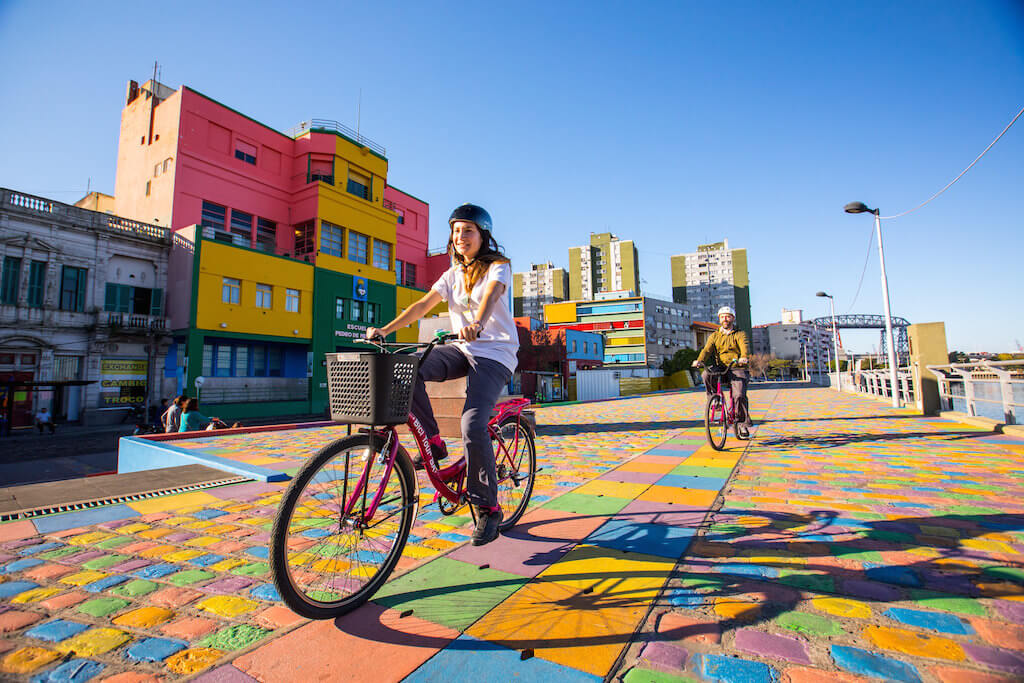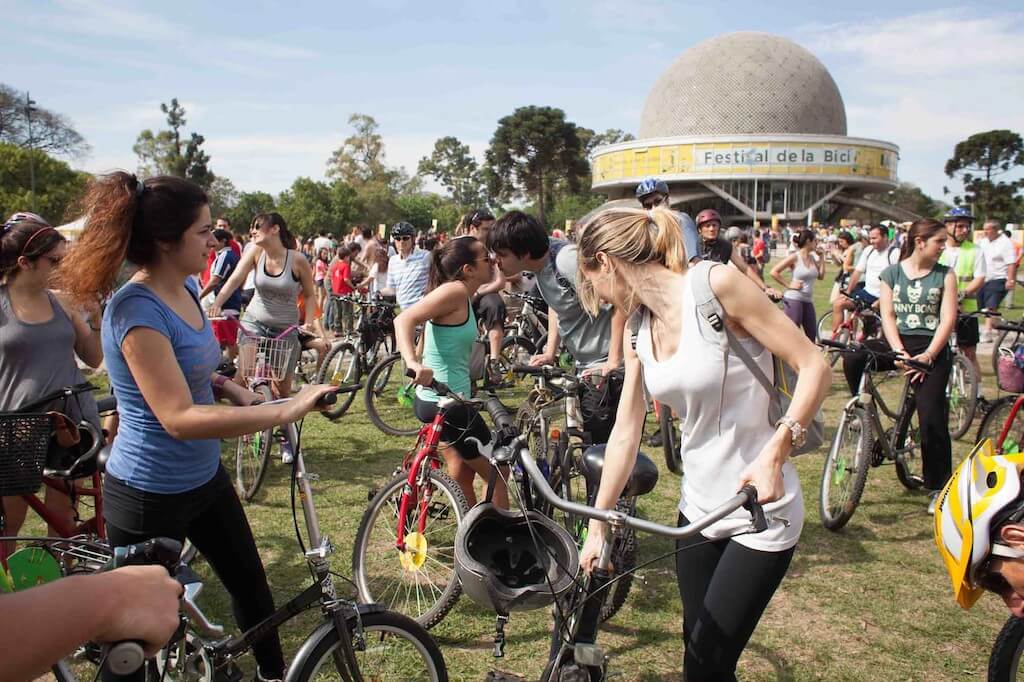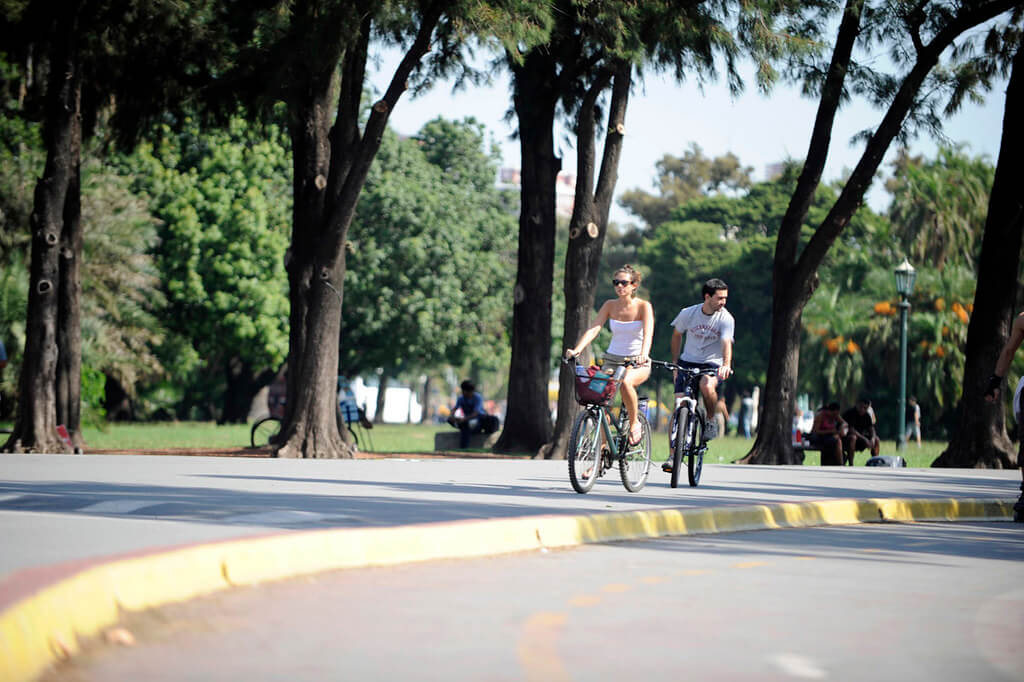Autumn Gear Guide
Find inspiration in our Gear Guide that will keep you out on your bike through wind or rain.
Download NowRecently a post on social media by C40 Cities, a global network of mayors taking urgent action to confront the climate crisis, hyped the strides made in the city of Buenos Aires on the cycling front. What was surprising, upon closer inspection, was the number of critical comments from locals. Apparently, Buenos Aires is not […]
Recently a post on social media by C40 Cities, a global network of mayors taking urgent action to confront the climate crisis, hyped the strides made in the city of Buenos Aires on the cycling front. What was surprising, upon closer inspection, was the number of critical comments from locals. Apparently, Buenos Aires is not all sunshine and separated bike lanes, so Momentum decided to get in touch with a couple of local cycling advocates to get their take.
Pablo Lebedinsky is one of those who commented on the post. He lives in the Argentinean capital of Buenos Aires and started cycling 10 years ago when he noticed some improvement in bike infrastructure. But, he says, more still needs to be done, and he doesn’t want C40’s appearance on the scene to cloud that fact.
“Buenos Aires is not still a cyclist city as officials try to make people believe. It is true that Buenos Aires is better with respect to urban cycling in the last 10 or 15 years, but it is also true that government did not do all it could have done in terms of infrastructure and road safety,” he explains. “So C40 Cities comes to Buenos Aires (and) tries to revitalize the image of (the) government. In my opinion, I think that this summit (C40 World Mayors Summit), in Buenos Aires will be able to do very little, but I hope that this government wakes up and puts everything on the table for the health of a city.”
More than a year ago, the city of Buenos Aires, with a population of more than 15 million, announced a goal of achieving 1 million daily bike rides by 2023. It is planning on building more bike lanes to add to the 250 km it has in place already. And the sooner the better. According to a World Economic Forum report, before the pandemic, Buenos Aires ranked as the 66th most congested city on the planet.

Lebedinsky says things are improving, but more needs to be done.
“For 15 years the bike lane network in Buenos Aires has been growing, with some plateaus along the way, but still making things better,” he says. “There was an explosion from the pandemic that also occurred around the world and that immediately showed the need to re-think infrastructure in the city. Activists have insisted for many years that bike lanes should be built into wide avenues, but officials told us the same thing every day: ‘No, it is dangerous and it is not technically doable.’ You can imagine what happened with the pandemic. Now, they have built bike lanes on two of the most iconic and most congested avenues of Buenos Aires: Cordoba and Corrientes.”
Leo Spinetto is the director of Bicivilizados, a blog dedicated to bicycles, public transport, ecology and urban planning. He thinks Buenos Aires does have the potential to improve as a cycling city.
“The latest data shows the city has about 1.5 million trips in private cars that do not leave the city limits and of those trips, there are about 70% that are under five kilometres,” he explains. “That, for me, is good news because it is totally feasible to encourage more commuter trips and the 15-minute city.”

Spinetto explains that when the pandemic hit, there was a big increase in cycling, as there was in cities around the world. But, the data suggests that most of the new people on bicycles probably came from public transit and not private cars. Not ideal.
“We also had several months in 2020 and 2021 where there was a very considerable increase in the use of private cars due to the fear of Covid and a significant drop in the use of public transport,” Spinetto says.
But even that is changing, he says.
“Currently, the use of transport has almost returned to pre-pandemic values, but the use of bicycles, which had risen in recent years, has remained fairly stable,” Spinetto explains. “Summer is coming and I suspect that the city will explode with cyclists like never before.”
According to Spinetto, the modal split in Buenos Aires has improved over the last 10-15 years.
“We have gone from having less than 1%, to being between 7% and 10% of bicycle use,” he says. “The City is fairly flat and does not have so many irregularities, which makes it quite easy to pedal. It stopped being a fad and is now an established means of transport.”
Spinetto says a lot of work needs to be done but agrees that Buenos Aires could become a cycling city with the right investment.

“A lot of work must also be done with the entire (Greater Buenos Aires) region with the two different governments to build better public transport networks and more bike lanes to connect large urban centers,” Spinetto stresses. “Almost the same population that inhabits it enters and leaves the city of Buenos Aires daily. Almost three million people have lived in it for more than 60 years and three million come and go every day, which is a job for this set of various jurisdictions, as well as for the job of the national administration.”
Lebedinsky says Buenos Aires is a great tourist town, and the international attention could help propel the city even further. It’s just not there yet.
He notes that the town bike share Ecobici surged during the pandemic with 4,000 bicycles in use at 400 stations.
“The system is not working now at its full capacity as the government promised a cuople of years ago,” Lebedinsky says. “Now it is at half capacity but it needs to be growing as people are hungry to consume that, now that bicycle usage is getting at higher levels.”
Lebedinsky and other cycling advocates are also trying to make officials understand that people need space to keep their bikes safe while they work or go to school. These are things that are lacking in Buenos Aires, and it’s a problem. Creating a cycling city is not just about bike lanes.
“Train stations, subway stations, big public hospitals and universities, big shopping centers need to have big, comfortable and acccesible bike storage with security personnel and the possibility to connect easily with public transit,” he explains.
Yes, more bike lanes, of course, he says, but also building up that complementary infrastructure along with public transit.
“Next should be continuing to build bike lanes into the avenues and to build up big bike storages in the main transportation centers, and permit people to combine bike with public transport, because intermodality is the key,” he says. “We do not have to keep prioritizing car usage, including free parking.”
In addition, he suggests modernizing the laws around transportation, which he says are obsolete and focussed entirely on cars without considering other vulnerable road users.
“Children, older adults and people with disabilities need to be included in the system and give them a way to safelty move around,” he adds. “There needs to be serious discusson about road safety because Buenos Aires traffic is kind of chaotic.”
So can Buenos Aires get there? Can it rival other great Latin American cycling cities or those of Europe like Copenhagen and now Paris?
“Buenos Aires has everything to be a cycling city, but we need to change culturally because most of the people have car culture mixed into their veins,” he says. “We grew up believing that to have a car was a sign of progress, now we know that this is not true. Cars nowadays are a health problem and we have the medicine which is cheaper, ecological, efficient: THE BICYCLE.”
You said it.
Interested in tapping into the Buenos Aires cycling scene follow Pablo and Leo on social media.
Find inspiration in our Gear Guide that will keep you out on your bike through wind or rain.
Download Now
Leave a comment